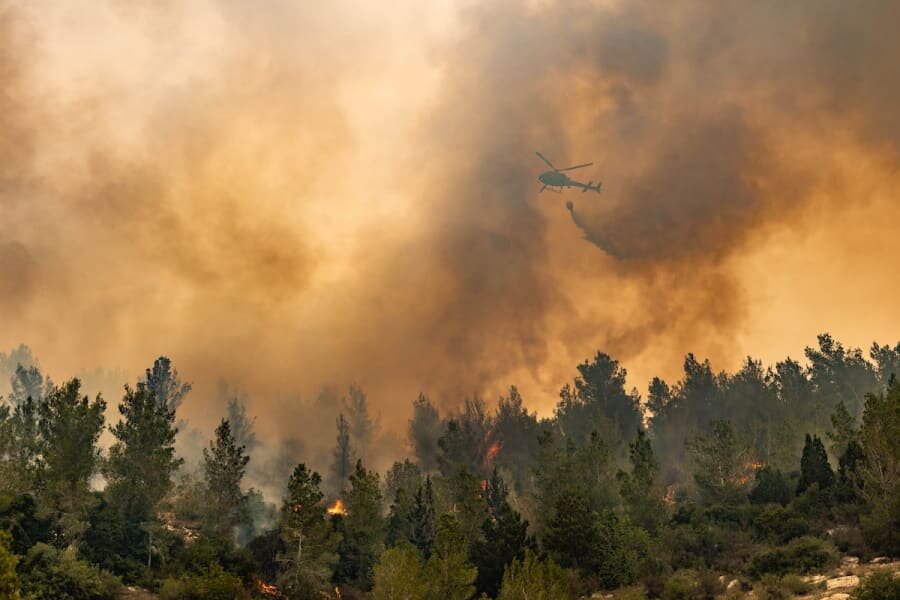MADRID – Israel is facing an ecological crisis as it destroys forests near Al-Kud, where bushfires are occupied. For two consecutive days, the fire team has struggled to control the flames. This has forced thousands of people to evacuate and close key communication routes.
The emergency that fell into the international side led Benjamin Netanyahu to declare an emergency and demand international aid. The image of firefighters fighting the flames is impressive, but this catastrophe serves as a wake-up call about the burning landscape and deeper layers of history in those flames.
Fires are not merely natural events, but they shed light on the deeper colonial side of the territory. Fire symbolically literally consumes landscapes created under projects that focus on changing land for political purposes, both symbolically and literally beyond agricultural and ecological goals. Nowadays, forests are not on fire, they are not the result of foreign interventions, they are the result of foreign interventions. The Jewish National Fund (JNF) planted tree species such as pine and eucalyptus native to Europe and Australia. These trees were planted in ruins of a Palestinian village that was destroyed during Nakba in 1948. This is a symbolic act that hides the violence of Zionist colonization behind the veil of vegetation.
Occupied Palestinian planting was one of the pillars of the Israeli state’s construction and was driven not only as an agriculture motive, but as a tool for identity integration and territorial management. Prime Minister David Ben Gurion called on Zionists to “bloom the desert” in his 1951 inauguration speech to Knesset. This phrase has become one of Zionism’s most iconic founding myths, appealing not only to the creation of new entities, but also to the recreation of “empty” lands that had to be changed by the hands of human hands, especially the Zionist settlers. Through planting these trees, Ben Gurion aimed to create jobs and strengthen the emotional connection of immigrants with the land, as well as to build symbolic ties with the territory. Planting was the act of diverting land, changing the landscape, and creating a new national tale that erased traces of the evacuated Palestinian people.
This process fits into one of the most enduring colonial ideologies. The myth of Terranurius, the idea of a land without people who discovered that Zionist settlers were empty and therefore could be used for colonization. According to this myth, Palestine was an unmanned territory, a hostile desert that gained value alone from the arrival of Zionist settlers. Still in modern Israeli discourse, this story is based on the idea that Jews are the only ones who can “redempt” the land and thrive. Under this framework, the Palestinians were not only invisible, but were also considered unable to cultivate their own lands that justified colonization.
The myth of “making desert flowers” is a clear example of how Zionist settlers use civilised rhetoric to justify the confiscation and destruction of Palestinian communities. The story is based on Orientalist stereotypes that, according to a colonialist vision, describe Western Asia as a backward, primitive, decadent place where only Europeans (or in this case, European Jews) can “civilize” the land. At the same time, it was a project that not only confiscated the Palestinians from their land, but also confiscated their history, identity and rights. Palestinian occupation on the colonial side was realized not only in the diversion of territory, but also in the transformation of the landscape to erase traces of Palestinian existence.
Resistance and the Islamic Republic: Anti-colonial resistance rooted in Islamic grammar
In this context, the axis of political presence and resistance in Iran’s Islamic Republic appears as an anti-colonial response to the Zionist colonization project. Since its founding in 1979, the Islamic Republic has provided an alternative perspective to hegemonic narratives that justify Zionist colonialism under the umbrella of civilization and the “red” of the desert. Islamic resistance, made largely clear by the figure of the Islamic Revolution and subsequent integration of Hezbollah, was a major political force in the region that openly challenged Israel’s expansionist aspirations.
The anti-colonial discourse on the axis of resistance is based on Islamic grammar that acknowledges the struggle for the liberation of Palestine as part of a broader struggle against global colonial structures. This approach opposes not only Zionist colonialism, but also neocolonial dynamics that characterized foreign force intervention in the region. The Palestinian struggle in this context is an integral part of the resistance of Western Asia and beyond, against the colonial forces that have reconstructed boundaries and landscapes according to their own geopolitical interests in pursuit of their control.
Iran’s opposition to Zionist colonialism is closely linked to Islam’s vision of promoting self-determination among the oppressed and condemning injustice. The discourse of the Islamic Revolution, focusing on social justice, the fight against tyranny and Muslim unity, was fundamental in not only rejecting the Zionist project, but also clarifying resistance against lasting forms of oppression, primarily by Israeli Israeli allies.
This resistance not only challenges Israeli occupation, but also challenges the story of Terranurius and the claim that Palestine is an empty land waiting to be civilized. Instead, members of the axis of resistance promote an anti-colonial vision that defends Palestinians’ self-determination and historical rights to restoration of their land.
The struggle against Zionist colonialism also led to discourses of colonization that expanded beyond the Palestinian borders. The axis of resistance is not only emphasizing the importance of the struggle against Israeli occupation, but also against a global power structure that supports the domination of foreign power over the Arab and Muslim worlds. This vision becomes a kind of continuation of the anti-imperialist struggle in terms of Islamic view that question not only Palestinian occupation but also Western intervention in other geopolitical contexts in the Islamic world.
Thus, fire consumes forests planted by Zionism, but it reveals a history of resistance, a lifelong struggle in the commitment of those opposed to Palestinian resistance and Zionist colonialism.

